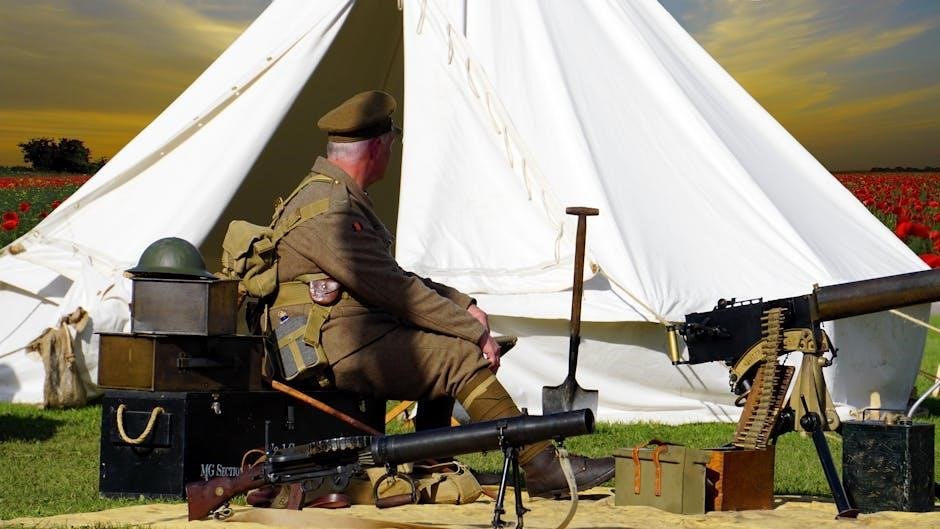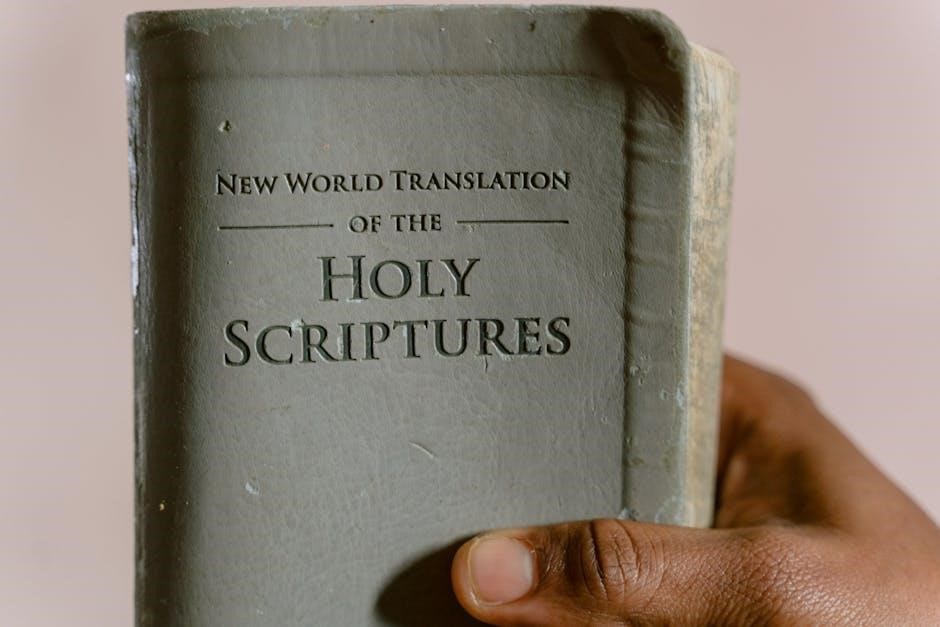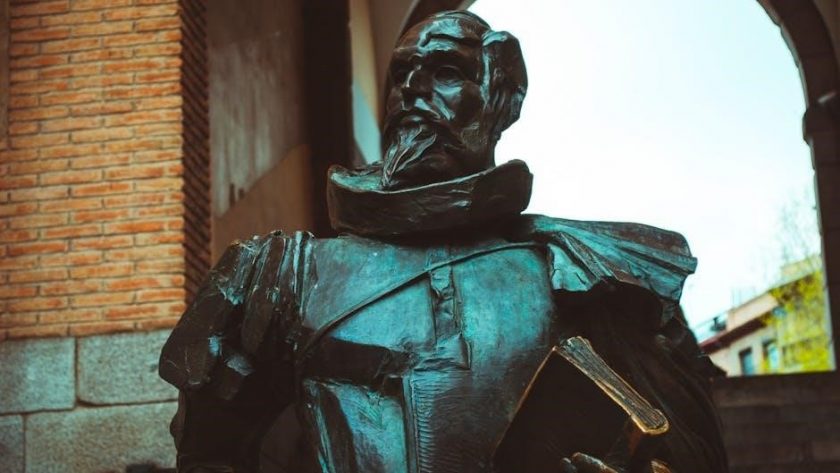Written by H.G. Wells in 1897, The War of the Worlds is a groundbreaking science fiction novel that explores a Martian invasion of Earth. Set in Victorian England, the story blends journalistic realism with gripping suspense, detailing humanity’s struggle against technologically superior alien forces. Its themes of colonialism, survival, and technological superiority resonate deeply, making it a timeless classic in the genre.
Overview of the Book
The War of the Worlds, written by H.G. Wells and serialized in 1897, is a seminal science fiction novel depicting a Martian invasion of Earth. Set in Victorian England, the story follows humanity’s desperate struggle against technologically superior alien forces. Its journalistic narrative style creates a sense of realism and urgency, while its exploration of themes like colonialism, technological superiority, and human resilience has made it a timeless classic. The novel’s influence on science fiction and popular culture remains profound, with its themes and imagery enduring to this day.
The Author: H.G. Wells
H.G. Wells, born Herbert George Wells in 1866, was a British author and visionary often regarded as the “father of science fiction.” His works, including The Time Machine and The War of the Worlds, explored futuristic themes and societal anxieties. Wells’s writing often blended scientific speculation with social commentary, reflecting his concerns about humanity’s future. His innovative storytelling and prophetic ideas continue to influence literature, film, and popular culture, ensuring his legacy as a pioneer of speculative fiction.
Historical Context of the Novel
The War of the Worlds was written during the late 19th century, a period marked by colonialism, rapid technological advancement, and rising global tensions. Published in 1897-1898, the novel reflects Victorian-era anxieties about empire, scientific progress, and the potential for global catastrophe. Wells drew inspiration from contemporary fears of invasion and the concept of Social Darwinism, using the Martian threat to critique British imperialism and explore humanity’s vulnerability. The novel’s themes resonate with the societal unease of its time, making it a timeless commentary on human fragility and resilience.

Plot Summary
The novel recounts a Martian invasion of Earth, beginning with observations of Mars and escalating into a devastating attack. Humanity struggles to survive against the Martians’ advanced technology, leading to societal collapse and a desperate fight for existence.
The Martian Invasion
The Martian invasion begins with the arrival of cylindrical spacecraft in England, unleashing towering war machines equipped with heat rays and black smoke. These advanced weapons devastate everything in their path, causing widespread panic and societal collapse. The Martians, with their superior technology, aim to conquer and colonize Earth, while humanity struggles to comprehend and resist the relentless assault. The narrative vividly portrays the terror and chaos, emphasizing humanity’s vulnerability against an unstoppable extraterrestrial force. The invasion serves as a backdrop to explore themes of survival, technology, and human resilience.
The Protagonist’s Journey
The unnamed protagonist’s journey in The War of the Worlds is a personal and emotional exploration of survival amidst chaos. Alongside his brother, he navigates the Martian invasion, witnessing societal collapse and human desperation. The protagonist’s experiences highlight themes of fear, resilience, and the human condition. As he struggles to survive, he encounters various characters, each with their own stories of struggle and hope. His journey culminates in a profound realization of humanity’s fragility and the unexpected conclusion to the Martian threat, leaving a lasting impact on his perspective of the world.
Key Events and Turning Points
The arrival of the first Martian cylinder in Woking initiates the invasion, showcasing the Martians’ technological superiority. The emergence of towering tripod machines and their devastating heat rays terrifies humanity. A pivotal moment occurs when the Martians release the Black Smoke, engulfing London and forcing mass evacuation. The protagonist’s reunion with his wife and the discovery of the Martians’ vulnerability to Earth’s bacteria mark crucial turning points. These events underscore humanity’s resilience and the unexpected conclusion to the conflict, emphasizing the fragility of both human and alien dominance.
Major Themes
The novel explores colonialism, technological dominance, and humanity’s resilience, reflecting Victorian anxieties about imperialism, societal collapse, and the contrast between human fragility and alien might.
Colonialism and Imperialism
Wells critiques colonialism by mirroring Britain’s imperialist practices through the Martian invasion. The novel portrays the Martians as ruthless colonizers, using superior technology to subjugate humanity, much like European powers exploited other cultures. This role reversal highlights the moral hypocrisy of imperialism, as the Martians justify their conquest similarly to how humans justified theirs. The narrative reflects Victorian anxieties about empire and power, offering a stark commentary on the exploitation and violence inherent in colonialism. This theme remains a powerful critique of historical and contemporary power dynamics.
Technological Superiority
The Martians’ advanced technology, including their towering tripod war machines and devastating heat rays, exemplifies their superiority over humanity. These machines, with their precision and power, symbolize the fear of being overwhelmed by unstoppable technological advancements. The heat rays, capable of incinerating everything in their path, underscore the Martians’ ruthless efficiency. Yet, despite their technological dominance, the Martians’ inability to adapt to Earth’s biology ultimately leads to their downfall, highlighting the limitations of relying solely on technology for conquest. This contrast between advanced machinery and biological vulnerability remains a central theme.
Human Resilience and Survival
The novel highlights humanity’s capacity for resilience and survival in the face of catastrophic invasion. As society collapses, individuals and small groups adapt, showcasing resourcefulness and determination. The protagonist’s journey through the chaos exemplifies personal endurance, while the collective struggle reflects a broader human spirit of resistance. The Martians’ ultimate defeat, not by human hands but by Earth’s biology, underscores the resilience of life itself. Wells’ portrayal of survival instincts and unity amidst despair remains a powerful commentary on human adaptability and the will to endure. The novel’s timeless appeal lies in its celebration of resilience.

Characters and Character Development
The unnamed protagonist and his brother are central figures, embodying human resilience. Their journeys reveal personal growth amidst chaos, while other characters, like the artilleryman, symbolize diverse human reactions to the invasion, enriching the narrative’s emotional depth and thematic exploration.
The Unnamed Protagonist
The unnamed protagonist serves as the reader’s lens into the Martian invasion, offering a personal and relatable perspective. His anonymity emphasizes the universal human experience of survival and fear. Through his journey, Wells explores themes of resilience, morality, and the breakdown of societal norms. The protagonist’s emotional and psychological development mirrors the broader chaos, making him a compelling yet ordinary figure in an extraordinary crisis. His narrative voice grounds the fantastical events in realism, allowing readers to connect deeply with the story’s tension and urgency.
The Protagonist’s Brother
The protagonist’s brother is a secondary character whose actions and decisions add depth to the narrative. His role highlights themes of family, responsibility, and survival instincts. Unlike the protagonist, he often acts impulsively, driven by fear and desperation. Their relationship illustrates the emotional toll of the invasion, as they face separation, reunion, and the struggle to maintain hope. His presence underscores the human element amidst the chaos, providing a contrast to the protagonist’s more reflective nature and the overwhelming alien threat.
Other Key Characters
Several secondary characters play pivotal roles in the narrative, each reflecting different aspects of human behavior during the crisis. The artilleryman represents resilience and resourcefulness, while the curate embodies faith and despair. The narrator’s wife symbolizes the emotional toll of separation and survival. These characters, though not central, enrich the story by showcasing diverse reactions to the invasion. Their interactions with the protagonist highlight themes of unity, sacrifice, and the breakdown of societal norms in the face of overwhelming adversity. Their stories add depth to the broader narrative of humanity’s struggle.

Narrative Style and Structure
H.G. Wells employs a journalistic narrative style, blending scientific speculation with vivid descriptions to create suspense and immediacy. The story’s episodic structure heightens the dramatic tension and realism.
Journalistic Narrative Approach
H.G. Wells’ The War of the Worlds employs a journalistic narrative style, blending factual details with fictional events to create a sense of realism. The novel is presented as a firsthand account, with the protagonist recounting the Martian invasion in a matter-of-fact tone. This approach enhances the story’s believability, drawing readers into the unfolding crisis. By incorporating real locations and scientific speculation, Wells crafts a narrative that feels both authentic and immersive, leaving readers with a chilling sense of immediacy and dread.
Realism and Suspense
H.G. Wells masterfully combines realism and suspense in The War of the Worlds, creating a gripping narrative that immerses readers in the Martian invasion. The novel’s vivid descriptions of Victorian England and the terrifying Martian war machines enhance its believability. Suspense is heightened through the relentless pace of the invasion and the collapse of societal order. Wells’ meticulous attention to detail and his ability to blend scientific speculation with everyday settings make the story both chilling and compelling, keeping readers on edge as humanity’s survival hangs in the balance.
Epistolary Elements
While The War of the Worlds is not strictly epistolary, it incorporates documentary-like techniques to enhance its realism. Wells employs a journalistic narrative style, presenting the story as a factual account of events. This approach, along with vivid descriptions of Martian technology and societal collapse, creates a sense of immediacy and authenticity. The novel’s epistolary elements, such as imagined witness testimonies and observational details, immerse readers in the unfolding crisis, making the alien invasion feel eerily plausible and heightening the suspense throughout the narrative.

Scientific and Technological Concepts
The novel explores advanced Martian technology, including towering war machines with heat rays, and interplanetary travel, showcasing Wells’ visionary ideas of futuristic warfare and alien capabilities.
Martian War Machines
The Martian war machines are towering, three-legged tripods equipped with devastating heat rays and black smoke, capable of destroying entire cities. Their advanced technology surpasses Victorian-era weaponry, making them nearly invincible. These machines symbolize the Martians’ technological superiority and serve as tools of mass destruction, instilling fear and chaos among humans. Wells’ vivid descriptions of these machines have become iconic in science fiction, influencing countless adaptations and cementing their place in pop culture as symbols of alien dominance and humanity’s vulnerability in the face of superior extraterrestrial force.
Heat Rays and Advanced Weapons
The Martians wield devastating heat rays, capable of disintegrating everything in their path, and black smoke that chokes life from the air. These advanced weapons, far beyond Victorian technology, symbolize the Martians’ ruthless efficiency and technological dominance. The heat rays, in particular, are described as intense, fiery beams that reduce cities and armies to ashes, exemplifying Wells’ vision of modern warfare’s horrors. These weapons not only destroy physically but also instill psychological terror, overwhelming humanity’s defenses and societal structures, highlighting the fragility of human civilization against superior alien technology.
Interplanetary Travel
The novel explores the concept of interplanetary travel through the Martians’ advanced technology. They launch cylindrical spacecraft from Mars, propelled by the planet’s explosive volcanic activity, which land on Earth near Woking, England. These vessels, carrying the Martians and their war machines, represent a groundbreaking vision of space travel in 19th-century literature. Wells’ depiction of interplanetary migration highlights humanity’s vulnerability and the possibility of life beyond Earth, themes that captivated readers and influenced later science fiction works.

Cultural and Social Commentary
The War of the Worlds reflects Victorian anxieties about imperialism and societal collapse. Wells critiques human hubris and class inequalities, portraying chaos as Martian invaders disrupt civilized order.
Social Darwinism
The War of the Worlds critiques Social Darwinism, a ideology popular during Wells’ time, which justified dominance through survival of the fittest. The novel mirrors human colonialism, as Martians exert ruthless superiority over Earth, echoing Victorian-era beliefs in racial and technological dominance. Wells subverts this by depicting humanity’s vulnerability, suggesting that brute force and advanced technology do not guarantee triumph. The Martians’ eventual defeat by bacteria underscores the limits of power and the unpredictability of survival, challenging the notion that might always prevails.
Victorian Society and Anxieties
The War of the Worlds reflects the anxieties of Victorian society, particularly fears of invasion and the decline of British imperial dominance. Wells taps into the era’s unease about scientific progress and the unknown, using the Martian invasion to mirror Victorian fears of racial and cultural contamination. The novel critiques societal complacency and explores the breakdown of social order, resonating with the period’s concerns about global stability and humanity’s vulnerability. Its vivid depiction of panic and chaos underscores the fragility of civilized life in the face of uncontrollable forces.
Global Unity and Conflict
The War of the Worlds highlights humanity’s initial fragmentation and panic in the face of the Martian invasion, showcasing how global conflict arises from fear and competition. However, the novel also suggests that such crises can unite humanity, as nations set aside differences to confront a common threat. Wells implies that external dangers, like the alien invasion, could inspire global cooperation, mirroring later historical responses to threats like nuclear war. The novel thus explores the tension between division and unity in the face of existential challenges.

Impact and Legacy
The War of the Worlds deeply influenced science fiction, inspiring countless adaptations, including the 1938 radio broadcast that caused widespread panic. Its exploration of humanity’s resilience against overwhelming odds remains timeless, cementing its legacy as a classic. The novel’s enduring popularity is evident in its widespread availability in PDF format, ensuring its reach to modern readers.
Influence on Science Fiction
The War of the Worlds is a foundational text in science fiction, pioneering the alien invasion narrative. Its blend of scientific speculation and social commentary inspired generations of authors, filmmakers, and creators. Wells’ vivid depiction of advanced technologies and interplanetary conflict set a benchmark for the genre, influencing iconic works like Star Wars and Independence Day. The novel’s exploration of humanity’s vulnerability and resilience continues to shape modern sci-fi, ensuring its enduring relevance in literature and popular culture.
Adaptations and Interpretations
The War of the Worlds has inspired countless adaptations, including the infamous 1938 radio broadcast by Orson Welles, which caused widespread panic. Numerous film adaptations, such as the 2005 version directed by Steven Spielberg, have reimagined the story for modern audiences. The novel has also been adapted into stage plays, comics, and even a musical. These interpretations highlight the timeless appeal of Wells’ narrative, ensuring its continued relevance in popular culture. The story’s adaptability underscores its enduring influence on science fiction and beyond.
Popular Culture References
The War of the Worlds has left an indelible mark on popular culture, inspiring countless references in media. From the 1938 radio broadcast that caused panic to modern retellings in films, TV shows, and music, the novel’s imagery and themes persist. The Martian tripods and heat rays have become iconic symbols, influencing sci-fi visuals globally. Even contemporary artists, like H.G. Wells’ work remixed in hip-hop, demonstrate its enduring appeal, proving the story’s ability to transcend time and medium, remaining a cultural touchstone for over a century.

Availability in PDF Format
The War of the Worlds is widely available in PDF format for free download from platforms like Global Grey and Planet PDF, offering easy access to readers worldwide.
Free Download Options
The complete eBook of The War of the Worlds is available for free download in PDF, EPUB, and Kindle formats from platforms like Global Grey and Planet PDF. These platforms offer unrestricted access without registration, allowing readers to enjoy the novel conveniently. Additionally, many websites provide options to read the book online for free. While donations are appreciated to support these services, they are not required to access the content. This ensures that H.G. Wells’ timeless classic remains accessible to everyone globally.
Platforms for Access
Multiple platforms offer easy access to The War of the Worlds in PDF format. Global Grey and Planet PDF provide free downloads, while sites like Perlego allow online reading. These platforms ensure the novel is readily available for readers worldwide, catering to various preferences and devices. Their user-friendly interfaces make downloading or reading the book straightforward, ensuring H.G. Wells’ iconic story remains accessible to a broad audience without any hassle or cost.
Features of the PDF Version
The PDF version of The War of the Worlds offers a seamless reading experience with clear formatting and adjustable text size. Available in both A4 and A6 formats, it is optimized for various devices, including smartphones, tablets, and e-readers. The PDF includes the full text of the novel, along with additional features such as notes on the text, a detailed table of contents, and information about the author’s life and works. These enhancements make the PDF a convenient and enriching way to enjoy this classic tale of alien invasion and human resilience.

Reception and Reviews
The War of the Worlds was an instant hit upon its 1898 release, praised for its gripping narrative and timeless themes. Modern reviews acclaim it as a sci-fi landmark, with academic analyses highlighting its enduring relevance and influence on the genre.
Initial Reception in 1898
Upon its release in 1898, The War of the Worlds garnered widespread acclaim for its innovative storytelling and chilling premise. The novel’s serialization in Pearsons Magazine and Cosmopolitan captivated readers, blending science fiction with contemporary anxieties. Critics praised Wells’ journalistic style, which lent authenticity to the alien invasion narrative. The public was enthralled by its vivid descriptions of Martian technology and the collapse of Victorian society; This groundbreaking work solidified Wells’ reputation as a pioneer of science fiction, leaving a lasting impression on literature and popular culture.
Modern Reviews and Ratings
Modern readers and critics continue to praise The War of the Worlds for its enduring relevance and masterful storytelling. The novel maintains high ratings on platforms like Goodreads and Amazon, with reviewers highlighting its timeless themes of humanity’s resilience and the dangers of complacency; Many commend Wells’ ability to evoke suspense and dread, while others appreciate the historical context and social commentary woven into the narrative. Its influence on science fiction remains unparalleled, ensuring its place as a classic in the genre.
Academic and Critical Analysis
Scholars hail The War of the Worlds as a seminal work in science fiction, praising its exploration of colonialism, imperialism, and humanity’s vulnerability. Critical analyses often focus on Wells’ use of a journalistic narrative style, which creates a sense of realism and immediacy. The novel’s themes of technological superiority and societal collapse are frequently examined in academic circles, with many interpreting it as a reflection of Victorian anxieties about progress and global dominance. Its enduring relevance has solidified its place in literary studies and cultural criticism.

Comparisons with Adaptations
The 1938 radio broadcast and subsequent film adaptations of The War of the Worlds have reimagined Wells’ original narrative, offering fresh interpretations while maintaining its core themes of invasion and survival.
The 1938 Radio Broadcast
The 1938 radio broadcast of The War of the Worlds, directed by Orson Welles, famously caused widespread panic due to its realistic news-bulletin style. Many listeners believed a real Martian invasion was underway, sparking fear and chaos. Broadcast on Halloween Eve, it remains a landmark moment in media history, blending drama with journalistic realism to create an unforgettable experience. This adaptation not only popularized Wells’ novel but also demonstrated the power of radio as a storytelling medium, leaving a lasting impact on popular culture and media.
Film Adaptions
Film Adaptions
The War of the Worlds has inspired numerous film adaptations, each offering a unique interpretation of Wells’ classic tale. The 2005 adaptation by Steven Spielberg, starring Tom Cruise, modernized the story, emphasizing human survival and emotional depth. Earlier versions, such as the 1953 film, stayed closer to the original narrative while incorporating Cold War-era anxieties. These adaptations highlight the novel’s enduring appeal, blending its timeless themes with contemporary cinematic techniques to captivate new audiences and honor Wells’ visionary work.
Modern Retellings and Reimaginations
Modern retellings of The War of the Worlds continue to captivate audiences, offering fresh perspectives on Wells’ timeless story. A 2019 Fox TV series reimagined the invasion in contemporary Britain and France, emphasizing suspense and character-driven drama. Additionally, stage productions and audio dramas have breathed new life into the narrative, blending original themes with modern storytelling. These reinterpretations demonstrate the novel’s enduring relevance, allowing it to resonate with today’s audiences while staying true to its core themes of survival and humanity’s resilience.
The War of the Worlds remains a timeless classic, influencing science fiction and popular culture. Its exploration of humanity’s resilience and technological challenges continues to captivate readers globally.
Timeless Relevance of the Novel
The War of the Worlds endures as a timeless tale due to its universal themes of humanity’s resilience, technological awe, and existential threats. Wells’ exploration of colonialism, imperialism, and societal collapse resonates across generations, mirroring modern anxieties about globalization and technological dominance. Its journalistic style creates a sense of immediacy, making the alien invasion feel eerily plausible. The novel’s ability to inspire both fear and scientific curiosity ensures its relevance, adapting seamlessly to new eras and audiences.
Enduring Appeal
The War of the Worlds captivates readers with its vivid depiction of extraterrestrial conflict and human survival. Wells’ masterful blend of suspense, realism, and social commentary ensures its enduring appeal. The novel’s exploration of fear, resilience, and technological superiority continues to resonate, making it a cherished classic in science fiction. Its influence on literature, film, and popular culture is unparalleled, ensuring its place as a must-read for generations exploring humanity’s vulnerabilities and strengths in the face of unknown threats.
Final Thoughts
The War of the Worlds remains a monumental work in science fiction, offering timeless reflections on humanity’s resilience and technological anxieties. Its accessible narrative style and enduring themes ensure its relevance across generations. As a free PDF, it’s easily accessible, allowing readers to experience Wells’ visionary storytelling firsthand. This novel not only entertains but also provokes thought, solidifying its legacy as a foundational text in the genre and a testament to Wells’ prophetic imagination.

